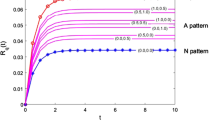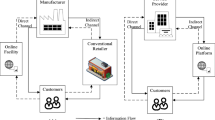Abstract
The rapid development of information technology has promoted the digital transformation of the service supply chain. Members can collect, store, and transform the value of data to gain profits. Due to the different roles during the service delivery, service integrators (SIs) and service providers (SPs) transform the data value from different sources, which leads to the demand and supply-driven data, respectively. As the leader of service supply chain, the SI may show altruistic behavior and share the data value with SPs. This study constructs a service supply chain consisting of two SPs and one SI and establishes five analytical models. Several important conclusions are obtained. First, the demand-driven data value leads to a decrease in the SI's optimal pricing and the SP's optimal value-added service level, leading to the “paradox of demand-driven data value”. Second, supply-driven data value leads to the increase in SI and SPs’ optimal decisions, and SI can get higher expected utility at no cost, achieving the "free-riding effect". Finally, there is a "transmission effect" among the altruistic behavior, demand-driven and supply-driven data value. When the parameters meet certain condition, customers can obtain an "optimal purchasing area" and obtain higher-level value-added service at a lower price.






Similar content being viewed by others
References
Aloysius, J. A., Hoehle, H., Goodarzi, S., & Venkatesh, V. (2018). Big data initiatives in retail environments: linking service process perceptions to shopping outcomes. Annals of Operations Research. https://doi.org/10.1007/s10479-016-2276-3
Baltacioglu, T., Ada, E., Kaplan, M., Yurt, O., & Kaplan, Y. C. (2007). A new framework for service supply chains. Service Industries Journal, 27(2), 105–124.
Boute, R., & Lambrecht, M. (2007). Altruistic behavior in supply chain management. Tijdschrift voor Economie en Management, 52(3), 499–513.
Brinch, M. (2018). Understanding the value of big data in supply chain management and its business processes: Towards a conceptual framework. International Journal of Operations & Production Management, 38(7), 1589–1614.
Cachon, G. P., & Fisher, M. (2000). Supply chain inventory management and the value of shared information. Management science, 46(8), 1032–1048.
Chen, D. Q., Preston, D. S., & Swink, M. (2015). How the use of big data analytics affects value creation in supply chain management. Journal of Management Information Systems, 32(4), 4–39.
Chen, H., Chiang, R. H., & Storey, V. C. (2012). Business intelligence and analytics: From big data to big impact. MIS Quarterly, 4(36), 1165–1188.
Choi, J. P., Jeon, D. S., & Kim, B. C. (2019). Privacy and personal data collection with information externalities. Journal of Public Economics, 173, 113–124.
Choi, S. C. (1991). Price competition in a channel structure with a common retailer. Marketing Science, 10(4), 271–296.
Choi, T. M., & Luo, S. (2019). Data quality challenges for sustainable fashion supply chain operations in emerging markets: Roles of blockchain, government sponsors and environment taxes. Transportation Research Part E: Logistics and Transportation Review, 131, 139–152.
Choy, K. L., Li, C. L., Stuart, C. K. S., & Henry, L. (2007). Managing uncertainty in logistics service supply chain. International Journal of Risk Assess Management, 7(1), 19–22.
De Janvry, A., McIntosh, C., & Sadoulet, E. (2010). The supply-and demand-side impacts of credit market information. Journal of development Economics, 93(2), 173–188.
Devalkar, S. K., & Krishnan, H. (2019). The impact of working capital financing costs on the efficiency of trade credit. Production and Operations Management, 28(4), 878–889.
Duan, C., Deng, C., Gharaei, A., Wu, J., & Wang, B. (2018). Selective maintenance scheduling under stochastic maintenance quality with multiple maintenance actions. International Journal of Production Research, 6, 1–19.
Fernando, Y., Chidambaram, R. R., & Wahyuni-TD, I. S. (2018). The impact of big data analytics and data security practices on service supply chain performance. Benchmarking: An International Journal, 25(9), 4009–4034.
Fu, Y., & Piplani, R. (2004). Supply-side collaboration and its value in supply chains. European Journal of Operational Research, 152(1), 281–288.
Gharaei, A., Hoseini Shekarabi, S. A., & Karimi, M. (2019a). Modelling and optimal lot-sizing of the replenishments in constrained, multi-product and bi-objective EPQ models with defective products: generalised cross decomposition. International Journal of Systems Science: Operations & Logistics, 35, 1–13.
Gharaei, A., Hoseini Shekarabi, S. A., Karimi, M., Pourjavad, E., & Amjadian, A. (2019b). An integrated stochastic EPQ model under quality and green policies: Generalised cross decomposition under the separability approach. International Journal of Systems Science: Operations & Logistics: Operations & Logistics, 42, 1–13.
Gharaei, A., Karimi, M., & Hoseini Shekarabi, S. A. (2019c). Joint economic lot-sizing in multi-product multi-level integrated supply chains: generalized benders decomposition. International Journal of Systems Science: Operations & Logistics, 23, 1–17.
Giri, B. C., & Masanta, M. (2018). Developing a closed-loop supply chain model with price and quality dependent demand and learning in production in a stochastic environment. International Journal of Systems Science: Operations & Logistics. https://doi.org/10.1080/23302674.2018.1542042
Gunasekaran, A., Papadopoulos, T., Dubey, R., Wamba, S. F., Childe, S. J., Hazen, B., & Akter, S. (2017). Big data and predictive analytics for supply chain and organizational performance. Journal of Business Research, 70, 308–317.
Harvey, J. (2016). Professional service supply chains. Journal of Operations Management, 42–43, 52–61. https://doi.org/10.1016/j.jom.2016.03.002
Henke, N., Bughin, J., Chui, M., Manyika, J., Saleh, T., Wiseman, B., & Sethupathy, G. (2016). The age of analytics: Competing in a data-driven world. McKinsey Global Institute.
Kazemi, N., Abdul-Rashid, S. H., Ghazilla, R. A. R., Shekarian, E., & Zanoni, S. (2016). Economic order quantity models for items with imperfect quality and emission considerations. International Journal of Systems Science: Operations & Logistics, 5(2), 99–115.
Li, C., Li, D. Y., Miklau, G., & Suciu, D. (2014). A theory of pricing private data. ACM Transactions on Database Systems (TODS), 39(4), 34.
Li, X., & Li, Y. (2016). Optimal service contract under cost information symmetry/asymmetry. Journal of the Operational Research Society, 67(2), 269–279.
Li, X., Wang, H., Liao, X., & Wen, L. (2018). Coordinating data pricing in closed-loop data supply chain with data value uncertainty. Available at SSRN 3120590.
Liu, W., Wang, D., Long, S., Shen, X., & Shi, V. (2019). Service supply chain management: A behavioural operations perspective. Modern Supply Chain Research and Applications. https://doi.org/10.1108/MSCRA-01-2019-0003
Liu, W., Wang, D., Shen, X., Yan, X., & Wei, W. (2018). The impacts of distributional and peer-induced fairness concerns on the decision-making of order allocation in logistics service supply chain. Transportation Research Part E: Logistics and Transportation Review, 116, 102–122.
Liu, W., Yan, X., Wei, W., Xie, D., & Wang, D. (2018). Altruistic preference for investment decisions in the logistics service supply chain. European Journal of Industrial Engineering, 12(4), 598–635.
Loch, C. H., & Wu, Y. (2008). Social preferences and supply chain performance: An experimental study. Management Science, 54(11), 1835–1849.
Niu, B., Wang, Y., & Guo, P. (2015). Equilibrium pricing sequence in a co-opetitive supply chain with the ODM as a downstream rival of its OEM. Omega, 57, 249–270.
Opresnik, D., & Taisch, M. (2015). The value of big data in servitization. International Journal of Production Economics, 165, 174–184. https://doi.org/10.1016/j.ijpe.2014.12.036
Razavi, R., & Israeli, A. (2019). Determinants of online hotel room prices: comparing supply-side and demand-side decisions. International Journal of Contemporary Hospitality Management, 31(5), 2149–2168.
Saxena, A., Claeys, D., Zhang, B., & Walraevens, J. (2019). Cloud data storage: A queueing model with thresholds. Annals of Operations Research, 293(3), 295–315.
Sengupta, K., Heiser, D. R., & Cook, L. S. (2006). Manufacturing and service supply chain performance: A comparative analysis. Journal of Supply Chain Management, 42(4), 4–15.
Shah, N. H., Chaudhari, U., & Cardenasbarron, L. E. (2020). Integrating credit and replenishment policies for deteriorating items under quadratic demand in a three echelon supply chain. International Journal of Systems Science: Operations & Logistics, 7(1), 34–45.
Shi, K. R., Zhou, Y., & Zhu, L. (2013). Impact of members’ different behaviors on supply chain cooperation. Journal of Nanjing Tech University (Social Science Edition), 12(2), 49–54. (in Chinese).
Srinivasan, R., & Swink, M. (2018). An investigation of visibility and flexibility as complements to supply chain analytics: An organizational information processing theory perspective. Production and Operations Management, 27(10), 1849–1867.
Ugray, Z., Paper, D., & Johnson, J. (2019). How business value is extracted from operational data: A case study: Driving transformation and innovation. Digital Business Models.
Urda, J., & Loch, C. H. (2013). Social preferences and emotions as regulators of behavior in processes. Journal of Operations Management, 31(1–2), 6–23.
Wang, D., Liu, W., Shen, X., & Wei, W. (2019). Service order allocation under uncertain demand: Risk aversion, peer competition, and relationship strength. Transportation Research Part E: Logistics and Transportation Review, 130, 293–311.
Wang, G., Gunasekaran, A., Ngai, E. W., & Papadopoulos, T. (2016). Big data analytics in logistics and supply chain management: Certain investigations for research and applications. International Journal of Production Economics, 176, 98–110.
Wang, L., & Dai, G. X. (2014). Altruism concern, service and the supply chain Stackelberg game research. Chinese Journal of Management Science, special issue, 66, 473–478. (in Chinese).
Wang, W., Feng, L., Li, Y., Xu, F., & Deng, Q. (2020). Role of financial leasing in a capital-constrained service supply chain. Transportation Research Part E: Logistics and Transportation Review, 143, 1–21. https://doi.org/10.1016/j.tre.2020.102097
Wang, Y., Wallace, S. W., Shen, B., & Choi, T. M. (2015). Service supply chain management: A review of operational models. European Journal of Operational Research, 247(3), 685–698.
Xia, Y., Chen, B., Jayaraman, V., & Munson, C. (2015). Competition and market segmentation of the call center service supply chain. European Journal of Operational Research., 247(2), 504–514.
Xinhua. (2018). Service industry steering China's firm growth. Retrieved July 31, 2018, from http://www.china.org.cn/business/2018-07/31/content_57904790.htm
Yin, S., Nishi, T., & Zhang, G. (2015). A game theoretic model for coordination of single manufacturer and multiple suppliers with quality variations under uncertain demands. International Journal of Systems Science: Operations & Logistics, 3(2), 79–91.
Acknowledgements
This research was funded by the National Natural Science Foundation of China (Grant Number No. 71672121). It also was funded by Major Program of the National Social Science Foundation of China (Grant Number No. 18ZDA060) and was funded by National Key R&D Program of China (Grant Number No. 2018YFB1601400). The reviewers’ comments are also highly appreciated.
Author information
Authors and Affiliations
Corresponding author
Ethics declarations
Conflict of interest
The authors declare that they have no conflict of interest.
Additional information
Publisher's Note
Springer Nature remains neutral with regard to jurisdictional claims in published maps and institutional affiliations.
Appendices
Appendix 1: Proof of Proposition 1
We first analyze SP2′s optimal strategy. It can be calculated by the Eq. (3) that \(\frac{{\partial^{2} U_{{SP_{2} }} }}{{\partial v_{2}^{2} }} = - 2ck < 0\), SP2′s utility function is concave in v2. In order to ensure that the SP’s optimal utility has the maximum value, \(p > 2ck\eta v_{2}\) needs to be satisfied, otherwise, when the SI's pricing is too low, the SP will not provide the value-added service. For a given optimal p and v1, SP2′s best response can be derived as \(v_{2}^{*} (v_{1} ,p) = \frac{p}{2\eta ck}\). Similarly, SP1′s utility function is concave in v1 and SP1′s best response is \(v_{1}^{*} (p) = \frac{p}{2k\eta }\) through the first-order-condition. By substituting the response functions \(v_{1}^{*}\) and \(v_{2}^{*}\) into Eq. (1), we have \(\frac{{\partial^{2} U_{SI} }}{{\partial p^{2} }} = \frac{ - (\eta - 1)[4b\eta ck - (1 - \theta )(c + 1)]}{{ck\eta^{2} }} < 0\), the optimal retail price p* of the SI can be derived through the first order optimal condition \(\frac{{\partial U_{SI} }}{\partial p} = 0,p^{NN*} = \frac{2ack\eta }{{4bck\eta - (1 - \theta )(c + 1)}}\), and the optimal value-added service level \(v_{SP1}^{NN*} = \frac{ac}{{4bck\eta - (1 - \theta )(c + 1)}},v_{SP2}^{NN*} = \frac{a}{4bck\eta - (1 - \theta )(c + 1)}\) can be obtained. The proof idea for the other four analytical models is similar, and the equilibrium solutions are shown in “Appendix 2”.
Appendix 2
See Table 4.
Rights and permissions
About this article
Cite this article
Wang, D., Liu, W., Liang, Y. et al. Decision optimization in service supply chain: the impact of demand and supply-driven data value and altruistic behavior. Ann Oper Res 324, 971–992 (2023). https://doi.org/10.1007/s10479-021-04018-y
Accepted:
Published:
Issue Date:
DOI: https://doi.org/10.1007/s10479-021-04018-y




